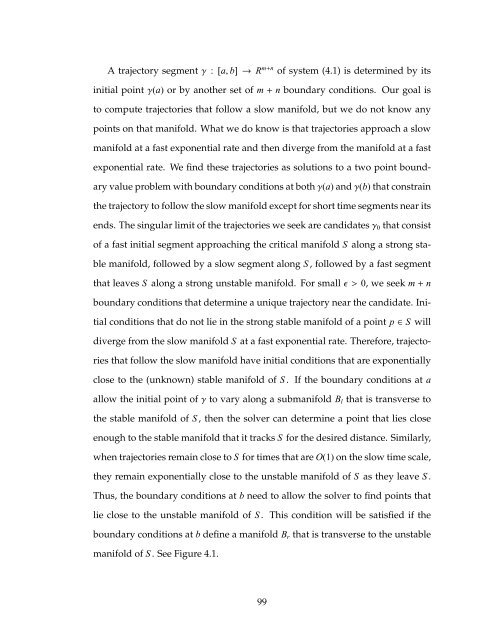multiple time scale dynamics with two fast variables and one slow ...
multiple time scale dynamics with two fast variables and one slow ...
multiple time scale dynamics with two fast variables and one slow ...
You also want an ePaper? Increase the reach of your titles
YUMPU automatically turns print PDFs into web optimized ePapers that Google loves.
A trajectory segmentγ : [a, b]→R m+n of system (4.1) is determined by its<br />
initial pointγ(a) or by another set of m+n boundary conditions. Our goal is<br />
to compute trajectories that follow a <strong>slow</strong> manifold, but we do not know any<br />
points on that manifold. What we do know is that trajectories approach a <strong>slow</strong><br />
manifold at a <strong>fast</strong> exp<strong>one</strong>ntial rate <strong>and</strong> then diverge from the manifold at a <strong>fast</strong><br />
exp<strong>one</strong>ntial rate. We find these trajectories as solutions to a <strong>two</strong> point bound-<br />
ary value problem <strong>with</strong> boundary conditions at bothγ(a) <strong>and</strong>γ(b) that constrain<br />
the trajectory to follow the <strong>slow</strong> manifold except for short <strong>time</strong> segments near its<br />
ends. The singular limit of the trajectories we seek are c<strong>and</strong>idatesγ0 that consist<br />
of a <strong>fast</strong> initial segment approaching the critical manifold S along a strong sta-<br />
ble manifold, followed by a <strong>slow</strong> segment along S , followed by a <strong>fast</strong> segment<br />
that leaves S along a strong unstable manifold. For smallǫ> 0, we seek m+n<br />
boundary conditions that determine a unique trajectory near the c<strong>and</strong>idate. Ini-<br />
tial conditions that do not lie in the strong stable manifold of a point p∈S will<br />
diverge from the <strong>slow</strong> manifold S at a <strong>fast</strong> exp<strong>one</strong>ntial rate. Therefore, trajecto-<br />
ries that follow the <strong>slow</strong> manifold have initial conditions that are exp<strong>one</strong>ntially<br />
close to the (unknown) stable manifold of S . If the boundary conditions at a<br />
allow the initial point ofγto vary along a submanifold Bl that is transverse to<br />
the stable manifold of S , then the solver can determine a point that lies close<br />
enough to the stable manifold that it tracks S for the desired distance. Similarly,<br />
when trajectories remain close to S for <strong>time</strong>s that are O(1) on the <strong>slow</strong> <strong>time</strong> <strong>scale</strong>,<br />
they remain exp<strong>one</strong>ntially close to the unstable manifold of S as they leave S .<br />
Thus, the boundary conditions at b need to allow the solver to find points that<br />
lie close to the unstable manifold of S . This condition will be satisfied if the<br />
boundary conditions at b define a manifold Br that is transverse to the unstable<br />
manifold of S . See Figure 4.1.<br />
99
















